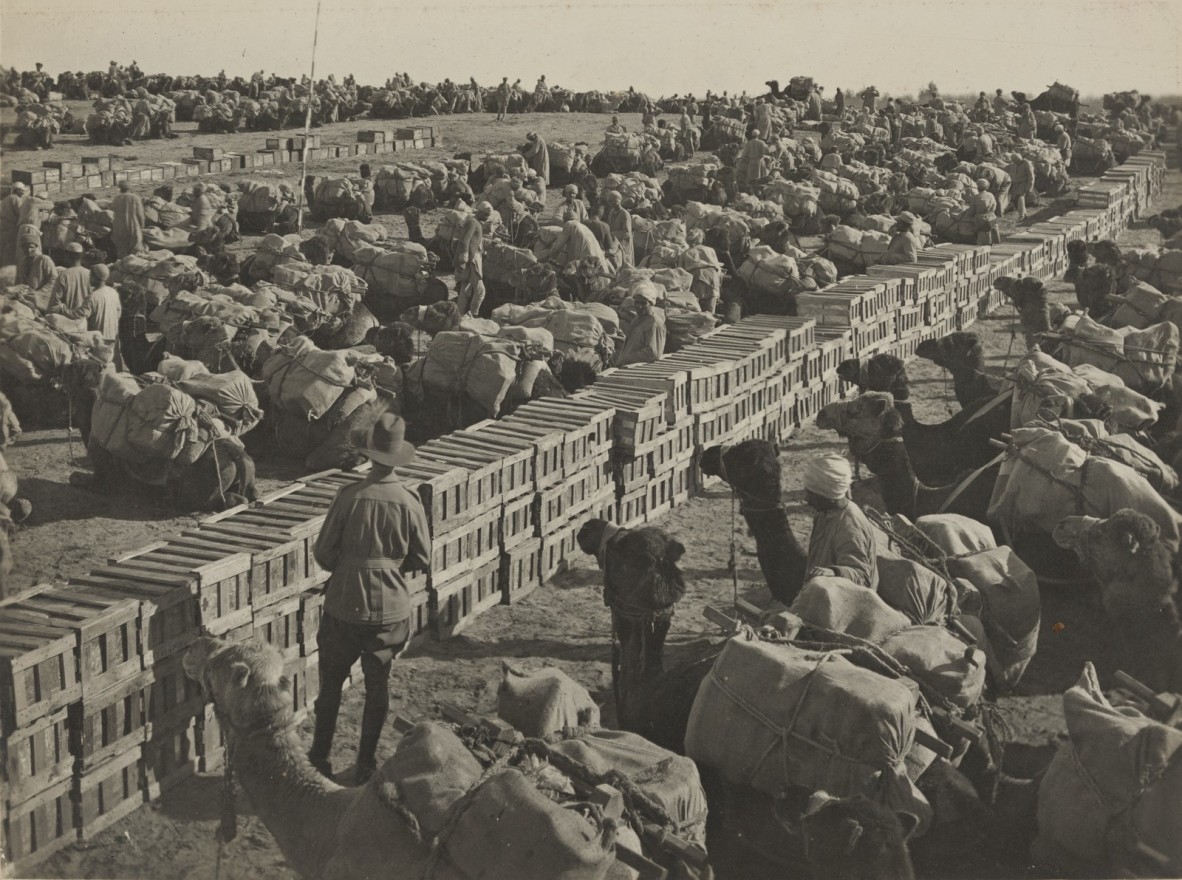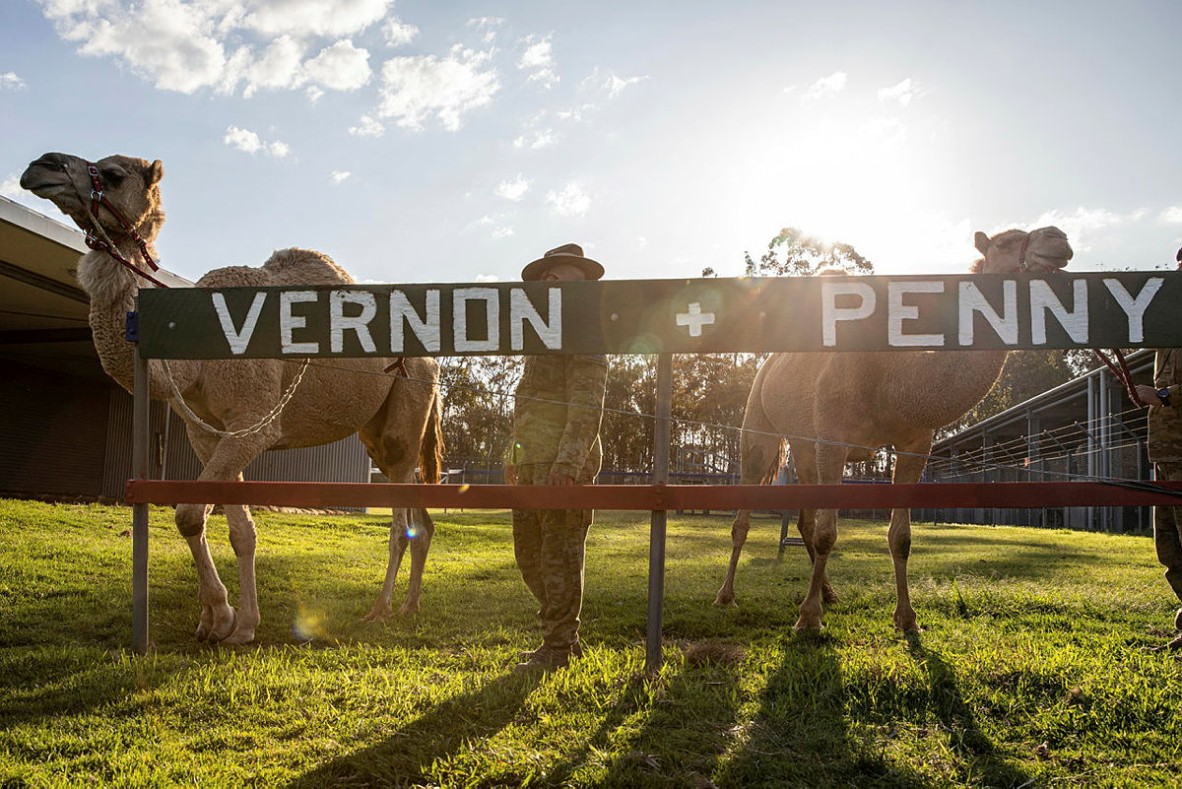The Bumpy History of the Imperial Camel Corps WWI
By Katherine Laundy, Visitor Services Officer, Visitor Services | 17 June 2024
Their blood stained the land, as they served with pride. A duty to their master, they stood side by side. From the sky, to the sea, through a vast open land, together they fought–both animal and man…Through the sand so fine, they lolloped to the fore, they’re the ships of the desert, the Camel Corp. Over hills and through valleys, the line did twine as they carried their loads to the firing lines.
Although war is an entirely human invention, many animals followed their human companions to the battlefield. In WWI alone, 9 million animals were deployed for service across the globe, serving as pack animals, messengers, transport animals, mascots and in many other roles. Despite there now being some recognition for the service of key animals such as horses, dogs, and mules–thanks to Simpson’s famous story–the camel’s role and sacrifice continues to be overlooked by many. Yet, it has been said that the Allies’ success in their desert campaigns would have been severely hindered if not for the aid of the camel.

Australian Army Service Corps transport camels during the First World War at Deiran, Israel, 1914-1918, OM77-14 2nd Light Horse Association Records, Image number: OM77-14-0023-0011.
Camels have been enlisted in times of war for thousands of years and were commonly used as the cavalry of the Middle East. They were also the perfect pack and transport animal, as they were able to carry up to 145 kg, go up to five days without water, and could travel at 4.8 to 9.5 kilometres per hour through the uneven desert terrain. Although they were commonly used to transport goods, they also worked as soldiers’ mounts and somewhat unpopular, bumpy ambulances. In this case, the wounded would be carried in Cacolets or cradle-like stretchers attached to either side of a camel’s hump. The lumbering and swaying gait of a camel made the Cacolets a dreaded and painful transport option for the wounded, but due to the sandy terrain of desert campaigns, there was often little choice.

Cacolets Carrying Wounded Soldiers being Loaded, One Each Side, Onto a Camel for Transport to a Medical Facility for Treatment, 1916-1917, Photograph Collection, Australian War Memorial.
The technological and mechanical limitations of vehicles at the time meant that most wheels were not able to traverse the desert landscape, which made animals invaluable to these campaigns. The camels in particular were also able to conduct longer, five-day desert patrols and succeeded where horses could not. Interestingly, an article in the Macleay Chronicle in 1918 also claimed that camels could be “stationed among clumps of acacia trees, with a spy mounted on…[their] necks” as they would look “precisely like a bit of foliage in the distance.” Thus, there was no doubt that camels were more effective than horses in the desert arenas, and that they fulfilled a number of vital duties.
It is no surprise then that the Imperial Camel Corp (ICC) was formed in January 1916, when the Senussi tribesmen of Egypt revolted in support of the Turkish and the Allies were forced to continue their engagement in desert battles. The ICC consisted of four battalions: the first and third were entirely Australian, the second was British, and the fourth was a mix of New Zealand and Australian men. Over 4000 camels were sourced from India and Egypt to support these forces.

Members of the Australian Imperial Camel Corps Preparing to Mount during the First World War in the Middle East, 1914-1918, n.d., 2nd Light Horse Association Records, John Oxley Library, State Library of Queensland.
It was less than a year later, on 6 September 1916, that the AIF command in Cairo requested more cameleers for their corps and suggested the men be taken from light horse regiments. The request was approved. The ICC, however, began to gain a bit of a reputation. This was not only because the majority were Australians (already renowned for their mischievous behaviour), but because many officers had offloaded their more troublesome soldiers when the call for cameleers arrived.
Their reputation was not all bad though. The Australians became known for their superior animal handling abilities and easy control over the camels: animals which almost all agreed were not easy to work with. The Townsville Daily Bulletin in 1918 praised our Australian cameleers by saying “not one Australian in a thousand had ever handled camels, and their adaptability was never put to a more severe test…The remarkable control won over the camel in a few weeks was a revelation…[They] mastered the camel by sheer determination and an intuitive sense of animal control.” On top of this, the corps achieved several early successes in Egypt and gained the respect of General Sir A.Murray, Commander-in-Chief of the Egyptian Expeditionary Forces, who wrote a letter of appreciation for the ICC after their involvement in the El Arish operations. He claimed, “the success obtained was due both to Chauvel’s brilliant handling of his troops and to the dash and gallantry displayed by all ranks.” The ICC also participated in the attack on Beersheba and the Battles of Maghdaba, Romani, and Gaza. Despite this, the ICC was disbanded in June 1918 as the fighting moved to the more mountainous landscapes of Northern Palestine where horses became more practical.
For all their benefits, camels were not initially well-loved by their riders. Major Oliver Hogue wrote: “none of us really liked our camels. Frankly, most of us loathed them. They were a necessary evil. In a desert campaign they were indispensable: so they were tolerated. But for many, many months the Cameleers cursed them without ceasing for the vilest, stupidest, craziest beasts that ever cumbered the earth.” He was not alone in this opinion. Camels are renowned for being stubborn, changeable, and bad tempered, which made them both difficult to control and unique individuals to which the soldiers would eventually become attached.

Soldiers Washing Camels in the Ocean El-Arish Palestina ca. 1917, 1917, George Hamilton Milson Photograph Album, John Oxley Library, State Library of Queensland.
Major Oliver Hogue continues: “then, suddenly…we began to realise some of the many virtues of the much-maligned camel…The reason for this volte-face, this sudden revulsion of feeling in favour of the camel, lay in the fact our camels were to be taken away from us.” Once word spread that the ICC was to be disbanded, many cameleers thought more kindly of their camels and realised the little luxuries they were afforded: the extra blankets and rations that could fit in a camel saddle, the reduced hours spent feeding, watering and grooming their mounts, and of course, the camel sports. The soldiers were not without sympathy for their camels, who had trekked through the desert alongside them and similarly suffered the hardships of desert campaigns. As such, Trooper Frank Reid noted that “we were sorry for the camels. Although we often cursed them, when they were to be taken away from us, we found that we had become quite attached to our ugly, ungainly mounts…we reckoned they were entitled to a long spell in country.”
Sadly, it is estimated that over 100 000 camels died during the First World War alone. This was due to both injury at the front lines, as well as disease, exhaustion, and the harsh conditions of a wartime desert. Camel service, however, did not end with the world wars.

Australian Army Soldiers Private Michael Giddy and Corporal Ryan Frost handle 26th Transport Squadron's mascots; camels Penny and Vernon, at 9th Force Support Battalion, RAAF Base Amberley, Queensland, Courtesy Department of Defence Australia.
Today, we still have Lance Corporals Vernon and Penny working as mascots for the 26th Transport Squadron while living at the RAAF Base in Amberly. Their main roles include boosting morale and conducting community engagement activities across Australia. The camel’s brave service and sacrifice should be remembered, alongside all animals that served in their varied roles and supported their human companions through the horrors of war.
References and Further Reading.
Animal Aid, (n.d.), ‘Messengers and Protectors: Animals in World War One-Part Two’, Animal Aid UK.
Australian War Memorial, (n.d.), ‘The Imperial Camel Corps’, Australian War Memorial.
Barrett J, (June 2019), ‘In Their Steps: the ADF and Camels’, Australian Army Journal.
Hogue O, (1919), ‘The Camel Brigade’, Journal of the Moruya & District Historical Society Inc.
The Macleay Chronicle, (20 February 1918), ‘Camels in War’, The Macleay Chronicle, Kempsey, NSW.
NAA: B539, AIF264/1/257, Proposal to Form Camel Companies in Cairo-Cablegram to Department of Defence, 6 September 1916.
NAA: B539, AIF112/2/1120, Letter of Appreciation of the ANZAC Troops of the Camel Corps, 1917.
Newcastle Morning Herald and Miners’ Advocate, (2 May 1919), ‘Camels’ Part in War’, Newcastle Morning Herald and Miners’ Advocate,NSW.
Powell M, (March 2015), ‘Desert Ambulances’, State Library of Queensland.
The Sydney Morning Herald, (22 February 1917), ‘Horses and Camels’, The Sydney Morning Herald, Sydney, NSW.
Townsville Daily Bulletin, (28 December 1918), ‘Anzacs Handle Camels’, Townsville Daily Bulletin, Townsville, QLD.
Wynn T and Wynn S, (2019), ‘Animals in the Great War’, Pen & Sword Military, South Yorkshire.
Comments
Your email address will not be published.
We welcome relevant, respectful comments.